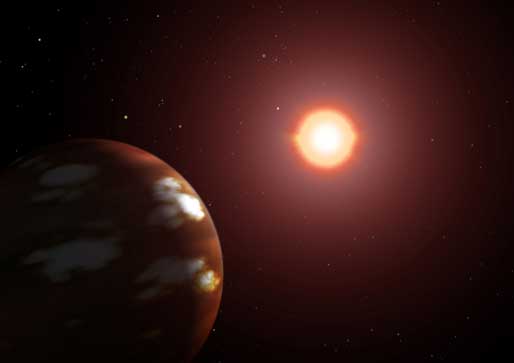Astronomers have just announced that they have found a near twin of Jupiter orbiting the star HD 154345, a fairly sunlike star about 60 light years away. This is very cool news, and has some pretty big implications for finding another Earth around some distant star.
 |
| Artist’s impression of an extrasolar planet. Courtesy NASA. |
Finding a planet like this isn’t as easy as it sounds! Finding planets with the same mass as Jupiter isn’t hard; many have been found with even lower mass. The hard part is finding one that is orbiting a sun-like star at the same distance Jupiter orbits our Sun. The closer in a planet is to its star, the easier it is to find: the method used measures how hard the planet’s gravity tugs on its parent star as it orbits; the planet pulls the star around just like the star pulls the planet, and we see this as a change in the velocity of the star toward and away from us (called the radial velocity; Wikipedia has a nice animated GIF for this), and that effect gets bigger with bigger planets, and the closer they orbit.
So we see lots of superjupiters orbiting close in, and some lighter planets also close to their parent stars. But finding a Jupiter-like planet on an orbit like Jupiter’s, well, that takes a long time to do. Jupiter takes 12 years to orbit the Sun, so it would take many observations over many years to detect a planet like that.
But they’ve done it! The team (Jason Wright, Geoff Marcy, Paul Butler, and Steven Vogt) have been using the monster 10-meter Keck telescope for ten years, observing HD 154345. This star is a lot like the Sun (it’s a G8, and the Sun is a G0 G2, meaning it’s a little smaller, lower mass, and cooler than the Sun). The planet (called HD 154345b) has a mass of no less than 0.95 times that of Jupiter, and orbits the star 4.2 AU out – 1 AU is the Earth-Sun distance, and Jupiter’s orbit is about 5.2 AU from the Sun. The planet takes a little over 9 years to orbit the star, and the orbit is circular.
 |
| As the planet orbits the star, the star’s velocity relative to us changes very slightly in a periodic fashion. In the case of HD 154345, the change in velocity over the course of several years is just 30 meters per second… about the speed of a car on a highway! |
This makes HD 154345b the first true Jupiter analog discovered. It’s a tremendous achievement!
So why is this important?
The superjupiters in tight orbits that have been discovered probably didn’t form that close to their stars; it’s a tough environment to form a big planet. The commonly accepted theory is that a planet like that forms farther out from the star and migrates closer in over millions of years, probably due to friction from the disk of gas and dust from which it formed.
Now imagine: you’re a planet that’s about the size of Earth, orbiting your star at about the same distance Earth is from the Sun. You’re pretty happy, thinking that in a few hundred million years, things’ll cool off, you’ll form oceans, and continents, and life. But then, hey, what’s that? Oh, it’s a planet with 500 times your mass, headed right for you! When it passes you by, its tremendous gravity either drops you into the star, or ejects you right out of the system!
Bummer.
So we don’t think that the stars that have close-in massive planets will have Earth-like planets. It may be that the only solar systems with planets like Earth will have their Jupiter analogs orbiting farther out, where they can’t hurt the smaller planets.
And hey, that’s just what we have here!
So, does HD 154345 have a blue-green ball orbiting it as well? These observations can’t say; they are only sensitive enough to find the Jupiter-like planet (and they can’t rule out planets farther out either). It might, or it might not. But here’s an interesting point: the system is probably about 2 billion years old. By that age, the Earth was already teeming with microscopic life. Provocative, eh?
I expect that future missions will spend quite a bit of time peering at this system. As of right now, it holds a lot of promise for those of us hoping that one day we’ll find another Earth.